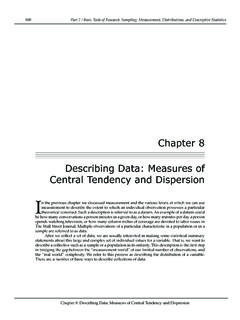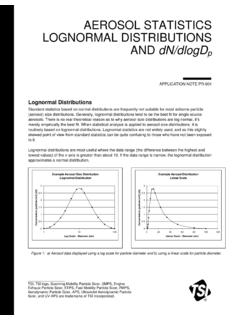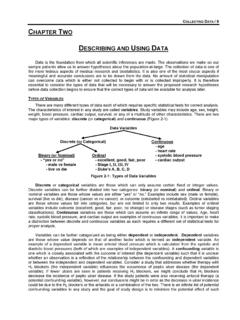Transcription of Statistics for Business and Economics
1 Statistics for Businessand EconomicsBy Stuart Strother and Orlando GriegoIncluded in this preview: Copyright Page Table of Contents Excerpt of Chapter 1 For additional information on adopting this book for your class, please contact us at x501 or via e-mail at FOR Business AND ECONOMICSBy Stuar t C. Strother & Orlando GriegoCopyright 2011 University Readers Inc. All rights reserved. No part of this publication may be reprinted, reproduced, transmitted, or utilized in any form or by any electronic, mechanical, or other means, now known or hereaft er invented, including photocopying, microfi lming, and recording, or in any information retrieval system without the written permission of University Readers, published in the United States of America in 2011 by Cognella, a division of University Readers, Notice: Product or corporate names may be trademarks or registered trademarks, and are used only for identifi cation and explanation without intent to 14 13 12 11 1 2 3 4 5 Printed in the United States of AmericaISBN: 978-1-60927-731-4 ContentsPar t One: Descriptive StatisticsChapter 1: Introduction 3 Chapter 2: Collecting Data 13 Chapter 3: Descriptive Statistics 31 Chapter 4: Descriptive Statistics .
2 Graphs 51 Par t Two: ProbabilityChapter 5: Probability 79 Chapter 6: Discrete Probability 97 Chapter 7: Continuous Probability: The Bell Cur ve 109 Chapter 8: Estimation and Confidence Inter vals 123 Par t Three: Hypothesis TestingChapter 9: Basic Hypothesis Testing 139 Chapter 10: Small Sample Hypothesis Tests 155 Chapter 11: The ANOVA Test 169 Chapter 12: Chi-Squared Tests 183 Par t Four: Correlation and RegressionChapter 13: Correlation and Regression 197 Chapter 14: Time Series Analysis 217 Chapter 15: Multivariate Regression 233 Chapter 16: Statistical Process Control 255 References 269 Appendices 271 Answers to Chapter Exercises 291 Index 309 Par t OneDescriptive StatisticsThe Yanjing Brewery employs a team of quality managers who inspect bottles of beer at their factory in Beijing, China. Each bottle should have a predetermined amount of liquid and air.
3 Too much liquid and the bottle will burst from the pressure of the carbonation. Too much air and the beer will be fl at. Th e job of the inspector is to pull bottles from the assembly line that have incorrect ratios of liquid and air. If the company can reduce the number of defective bottles that end up in shops and restaurants, the company will be more profi table. Th e inspectors report their fi ndings to company managers using descriptive Statistics . In Part One of this textbook we focus on descriptive Statistics . We will describe large sets of data using numeric Statistics such as mean and range, and graphs such as pie charts and bar charts. Th e fi rst chapter begins with introductory concepts that are important to the study of Statistics . Because it is important to know where data come from before analyzing those data, our second chapter describes data collection techniques.
4 Th e third chapter covers numeric Statistics and the fourth chapter describes employee at the Yanjing Brewery in Beijing inspects bottles of beer. Photo: Barbara L. StrotherIntroduction | 3 Chapter Chapter introductionStatistics is the science of collecting data, describing data, and interpreting data for eff ective decision making. Virtually every fi eld uses some form of statistical analysis, which is why most college majors include a Statistics course. Th e ability to collect, describe, and interpret data is an essential part of a successful career in today s marketplace. If you learn the basic statistical techniques presented in this textbook, you will be a producer of statistical analysis, which will help you make decisions; you will also learn to be a good consumer of information, which will help you understand the analyses and decisions of is textbook is written for students of Business and Economics , so the examples and applications come from the world of Business and Economics .
5 Most of the statistical techniques described in this book, however, are applied techniques that are used in other fi elds including medicine, sociology, psychology, and others. Professionals in all these fi elds use statistical analysis in their decision-making process. To succeed in mastering the applied statistical techniques presented in this book, we have learned that a typical student needs multiple exposures to the material. He or she should read the text before attending class, practice the end-of-chapter exercises, keep a running list of the formulas, and learn the key vocabulary words. Be careful though! Th e study of Statistics has never been easy. We have made every eff ort to make the material as simple as possible, and we are confi dent that if you apply yourself, you will How this book is organizedTh is book is organized in four sections.
6 Th e fi rst section describes data collection and descriptivestatistical techniques, which are ways of organizing and describing raw data. Raw data is informa-tion that has been collected, but not organized in any way, such as these shoe prices at the Azusa, California Ross store:$ $ $ $ $ | Statistics for Business and Economics With only fi ve pairs of shoes, we can get some ideas about the Ross store s pricing policies just by reviewing the raw data (about $30 for a pair of shoes), but this would be more diffi cult with 500 pairs of shoes. Instead of reporting raw data, we can use descriptive statistical techniques to better represent these data. For instance we can use numbers such as mean, median, or mode, or we can use graphs such as a column chart or a pie chart. Th e second section of this book describes probability techniques, which are methods of determin-ing the likelihood of an event happening in the future.
7 Th is is quite useful in Business , as managers make many decisions based on forecasts. If consumer demand will be high, a company needs to increase production in advance. If the economy is heading into recession, fi rms will cut back on production and hiring. Probability analysis is a critical part of Business decision making. Th e third section of the book covers hypothesis testing, which are techniques to determine whether two or more things are the same or diff erent. In the recession of 2008 2009, many heavy equipment manufacturers such as Caterpillar and Kobelco are not planning on selling as much of their product as in previous years. How about companies in other industries? Should video game manufacturers such as Sony, Activision, and Nintendo follow the same strategy? Th at depends on whether or not consumer demand for video games is the same as for other products.
8 Some people think video game sales are recession-proof. We can test this hypothesis (and give Mario and Sonic a hand) using the techniques described later in the e fourth and fi nal section of the book describes correlation and regression, which are techniques for measuring the association between two or more variables. For example we will analyze the re-lationship between the number of bedrooms in a house and its price. Of course we expect a house Photo: Stuart C. StrotherEach year, companies such as Kobelco use statistical techniques to forecast demand for their | 5with more bedrooms to cost more, but how much more? And what about a garage or a pool? Th ese questions can be answered using correlation and regression Statistics and the scientific methodMost research follows what has become known as the scientifi c method, which is a process of trying to discover some truth (or perhaps disprove some fallacy).
9 Steps of the scientifi c method are 1) defi ne the question, 2) gather information and resources, 3) form hypotheses, 4) perform experiments and collect data, 5) analyze data, 6) interpret data, and 7) publish results. Th e fi rst few steps are more theoretical and require some knowledge of the fi eld of study and the existing body of knowledge in that fi eld. Before doing analysis of a topic, such as the eff ectiveness of local economic development policies, it is important to conduct a literature review on that topic to ensure that your research will in fact add something new and important to the existing state of knowledge. As scientists say, new work must advance knowledge. Most of the statistical techniques in this textbook fi t within the fi ft h step of the scientifi c method. Th at is, we will analyze data that have already been collected.
10 To successfully analyze data, it is important to understand how data are collected, thus we start in Chapter 2 by introducing some frequently used data-collection techniques. To successfully interpret data (step 6 of the scientifi c method), researchers need to rely on their existing knowledge of the fi eld, which should have been sharpened in the fi rst few steps. Notice also the fi nal step in the scientifi c method, which is publish-ing the results. In this textbook we focus on accurate analysis, but do not overlook the importance of publishing your results with brevity, clarity, and professionalism. Types of dataData are either quantitative or qualitative. Quantitative data are numeric data, such as the net worth of Britney Spears ($100 million, as reported by Forbes magazine). We could also report the same data qualitatively by saying the pop queen is rich.











